Monuments
26th Division Tablets of the Fallen (WW1)
ISOB Thomas Plummer -American Red Cross
LT Thomas Rodman, American Red Cross, Memorial Plaque
Espace 1LT Robert Hewins Stiles -13th Aero Squadron

When Charles Warner Plummer was born on May 25, 1890, in Massachusetts, his father, Henry, was 24 and his mother, Alice, was 27. He had three brothers. Plummer then received his bachelor's degree from Harvard University in Cambridge, Massachusetts in 1914. He briefly worked for Northwestern Mutual Life Insurance Company before enlisting with Battery A of the 101st Field Artillery Regiment in Massachusetts of the American Expeditionary Forces. Plummer helped drive off more than a dozen biplanes of the German Air Force before five German airplanes shot down his plane.
These actions helped Plummer's squadron capture 30 critical photographs of German enforcements and earned him the Distinguished Service Cross, the American military's second highest honor.
General John J. Pershing awarded Plummer the medal in the name of President Woodrow Wilson in October of 1918. In an earlier mission, Plummer received France's Croix de Guerre for defending aviators from his squadron despite receiving 30 bullets in his own airplane. He also received a medal from the Aero Club of America that recognized his aviation achievements. Plummer and his pilot received burial on a knoll overlooking a valley in Chierry, France. The grave carries a marking of a propeller blade, customary for many aviators killed in World War I.
He died on August 11, 1918 in France at the age of 28 and is now buried in Oise-Aisne American Cemetery, Seringes-et- Nesles, France. He also has a memorial in Rural Cemetery, New Bedford, Bristol County, Massachusetts, USA.
His uncle, Lieutenant Thomas Rodman Plummer served with the American Red Cross for the entire war in the Vosges section of France and he died just as the war ended. His uncle was during with military honor and lies in the communal cemetery of Moyenmoutier, France in an Isolated Burial.
DCS Citation:
Distinguished Service Cross
AWARDED FOR ACTIONS
DURING World War I
Service: Army Air Service
Battalion: 88th Aero Squadron (Attached)
Division: American Expeditionary Forces
GENERAL ORDERS:
War Department, General Orders No. 44 (1919)
CITATION:
The President of the United States of America, authorized by Act of Congress, July 9, 1918, takes pride in presenting the Distinguished Service Cross (Posthumously) to Second Lieutenant (Field Artillery) Charles W. Plummer, United States Army Air Service, for extraordinary heroism in action while serving with 88th Aero Squadron (Attached), 101st Field Artillery Regiment, U.S. Army Air Service, A.E.F., near Fismes, France, 11 August 1918. John W. Jordan, second Lieutenant, 7th Field Artillery, observer; Roger W. Hitchcock, second lieutenant, pilot; James S. D. Burns, deceased, second lieutenant, 165th Infantry, observer; Joel H. McClendon, deceased, first lieutenant, pilot; Louis G. Bernheimer, first lieutenant, pilot; Philip R. Babcock, first Lieutenant, pilot; and Joseph A. Palmer, second lieutenant, 10th Field Artillery, observer. All of these men were attached to the 88th Aero Squadron, Air Service. Under the protection of three pursuit planes, each carrying a pilot and an observer, Lieutenants Bernheimer and Jordan, in charge of a photo plane, carried out successfully a hazardous photographic mission over the enemy's lines to the River Aisne. The four American ships were attacked by 12 enemy battle planes. Lieutenant Bernheimer, by coolly and skillfully maneuvering his ship, and Lieutenant Jordan, by accurate operation of his machine-gun, in spite of wounds in the shoulder and leg, aided materially in the victory which came to the American ships, and returned safely with 36 valuable photographs. The pursuit plane operated by Lieutenants Hitchcock and Burns was disabled while these two officers were fighting effectively. Lieutenant Burns was mortally wounded and his body jammed the controls. After a headlong fall of 2,500 meters, Lieutenant Hitchcock succeeded in regaining control of this plane and piloted it back to his airdrome. Lieutenants McClendon and Plummer were shot down and killed after a vigorous combat with five of the enemy's planes. Lieutenants Babcock and Palmer, by gallant and skillful fighting, aided in driving off the German planes and were materially responsible for the successful execution of the photographic mission.
Source of information: www.findagrave.com
